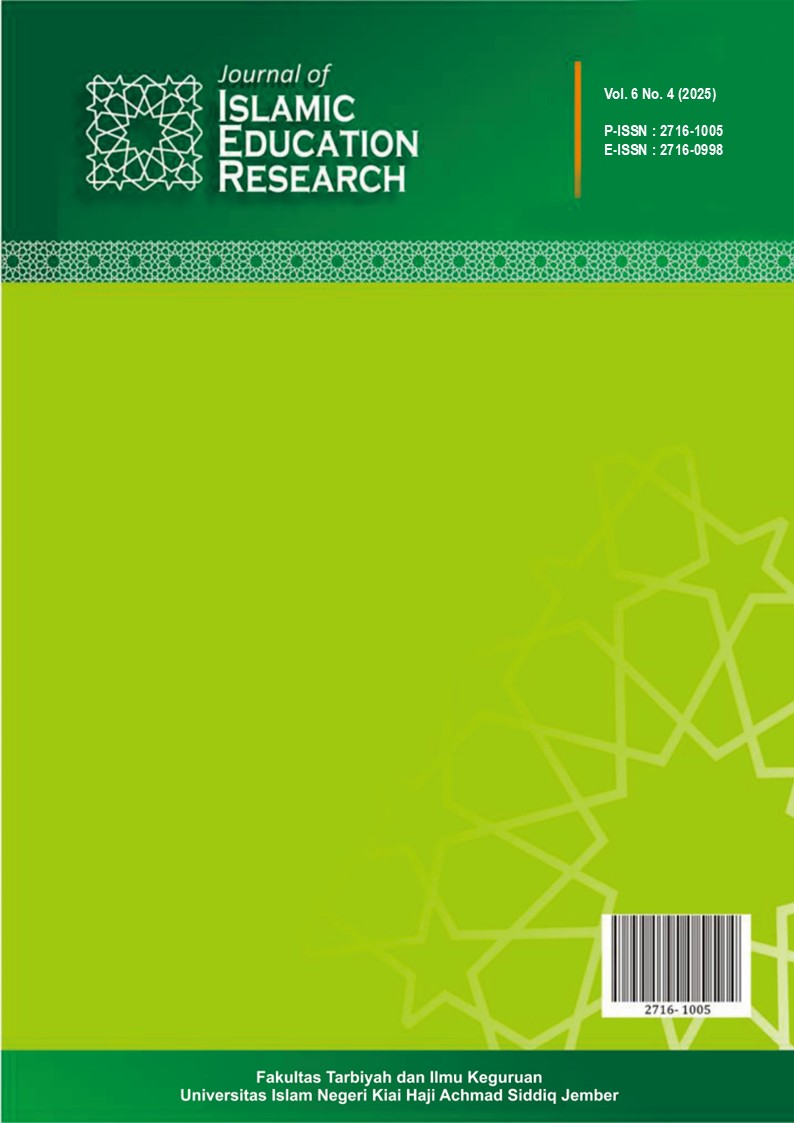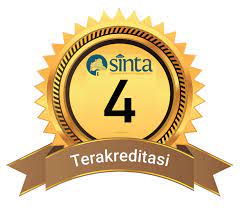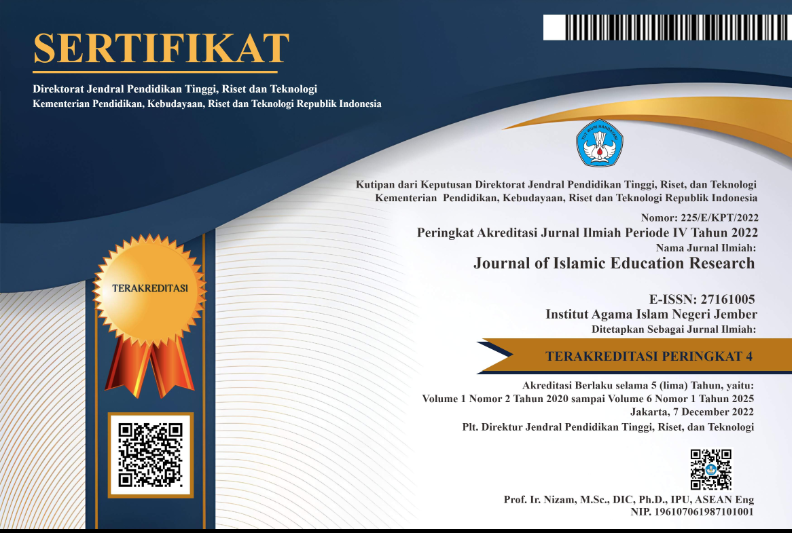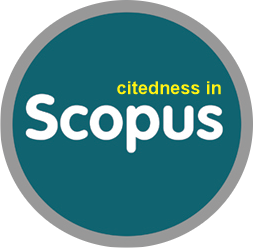Digital Media and School Environment as Predictors of Learning Interest in Islamic Education: Evidence from Indonesia’s Integrated Islamic Schools
DOI:
https://doi.org/10.35719/jier.v6i4.530Keywords:
Digital media, school environment, learning interest, Islamic Education, IndonesiaAbstract
This study examines how digital learning media and the school environment function as predictors of students’ learning interest in Islamic Education within Indonesia’s Integrated Islamic Schools. Using a quantitative approach and multiple linear regression analysis, data were collected through a validated and reliable questionnaire administered to all 103 students of SMP IT Permata Probolinggo using saturated sampling. The findings show that digital learning media (p = 0.003; t = 3.018) and the school environment (p = 0.005; t = 2.873) each have a significant partial effect on students’ learning interest. Simultaneously, both variables significantly predict learning interest (p = 0.000) with an R² value of 0.660, indicating that 66% of the variance in learning interest is explained by the two predictors. These results confirm that the integration of interactive digital media and a conducive school environment is essential for enhancing student engagement and interest in Islamic Education. Schools must therefore optimize technology-supported learning while strengthening an academically supportive environment.
Penelitian ini mengkaji bagaimana media pembelajaran digital dan lingkungan sekolah berperan sebagai prediktor minat belajar Pendidikan Agama Islam (PAI) di Sekolah Islam Terpadu di Indonesia. Pendekatan kuantitatif digunakan dengan analisis regresi linier berganda. Data dikumpulkan melalui kuesioner yang telah diuji validitas dan reliabilitasnya, melibatkan seluruh 103 siswa SMP IT Permata Probolinggo melalui teknik sampling jenuh. Hasil penelitian menunjukkan bahwa media pembelajaran digital (p = 0,003; t = 3,018) dan lingkungan sekolah (p = 0,005; t = 2,873) berpengaruh signifikan secara parsial terhadap minat belajar siswa. Secara simultan, kedua variabel juga berpengaruh signifikan (p = 0,000) dengan nilai R² sebesar 0,660, yang berarti 66% variasi minat belajar dijelaskan oleh kedua prediktor tersebut. Temuan ini menegaskan bahwa integrasi media digital interaktif dan lingkungan sekolah yang kondusif sangat penting untuk meningkatkan keterlibatan dan minat belajar siswa pada mata pelajaran PAI. Sekolah perlu mengoptimalkan pembelajaran berbasis teknologi dan sekaligus memperkuat iklim pembelajaran yang mendukung.
Downloads
References
Abdul Latip, M. S., Abdul Latip, S. N. N., Tamrin, M., & Rahim, F. A. (2025). Modelling physical ergonomics and student performance in higher education: the mediating effect of student motivation. Journal of Applied Research in Higher Education, 17(3), 1081-1098. https://doi.org/10.1108/JARHE-01-2024-0052
Akram, H., & Li, S. (2024). Understanding the role of teacher-student relationships in students’ online learning engagement: Mediating role of academic motivation. Perceptual and Motor Skills, 131(4), 1415-1438. https://doi.org/10.1177/00315125241248709
Alalwan, N. (2022). Actual use of social media for engagement to enhance students' learning. Education and Information Technologies, 27(7), 9767-9789. https://doi.org/10.1007/s10639-022-11014-7
Alenezi, M. (2023). Digital learning and digital institution in higher education. Education Sciences, 13(1), 88. https://doi.org/10.3390/educsci13010088
Arifin, E. P. R., & Fadillah, F. P. (2025). Upaya meningkatkan keterlibatan siswa sekolah dasar melalui media pembelajaran interaktif berbasis Wordwall. Jurnal Ilmiah Multi Disiplin, 3(3), 1298–1305. https://ojs.smkmerahputih.com/index.php/jimu/article/view/771
Arikunto, S. (2019). Prosedur penelitian: Suatu pendekatan praktik. Rineka Cipta.
Aseery, A. (2024). Enhancing learners’ motivation and engagement in religious education classes at elementary levels. British Journal of Religious Education, 46(1), 43-58. https://doi.org/10.1080/01416200.2023.2256487
Burke, C. M., Montross, L. P., & Dianova, V. G. (2024). Beyond the classroom: An analysis of internal and external factors related to students’ love of learning and educational outcomes. Data, 9(6), 81. https://doi.org/10.3390/data9060081
Cayubit, R. F. O. (2022). Why learning environment matters? An analysis on how the learning environment influences the academic motivation, learning strategies and engagement of college students. Learning Environments Research, 25(2), 581-599. https://doi.org/10.1007/s10984-021-09382-x
Chang, Y. S. (2021). Applying the arcs motivation theory for the assessment of ar digital media design learning effectiveness. Sustainability, 13(21), 12296. https://doi.org/10.3390/su132112296
Daramola, M. A., Okunade, A. I., Jegede, R. O., & Okeya, A. E. (2024). A Critical Evaluation of the Vygotsky’s Socio-Cultural Theory as Evident within an Aspect(s) of Curriculum, Pedagogy and/or Assessment in Nigeria. TWIST, 19(2), 583-588. https://twistjournal.net/twist/article/view/437
Deel, Michael Shan, "A Phenomenological Study of the Influence of Student-Centered Learners on Traditional Teacher-Centered Faculty in Medical Education" (2024). Doctoral Dissertations and Projects. 5802.
https://digitalcommons.liberty.edu/doctoral/5802
Edgerton, E., & McKechnie, J. (2023). The relationship between student’s perceptions of their school environment and academic achievement. Frontiers in Psychology, 13, 959259. https://doi.org/10.3389/fpsyg.2022.959259
El Zaatari, W., & Maalouf, I. (2022). How the Bronfenbrenner bio-ecological system theory explains the development of students’ sense of belonging to school?. Sage Open, 12(4). https://doi.org/10.1177/21582440221134089
Fauziyah, N., Afendi, A., Saputra, M., & Kamaria, K. (2023). Pemanfaatan Aplikasi Tiktok dalam Mata Pelajaran PAI sebagai Media Pembelajaran Inovatif Era Digital. Borneo Journal of Islamic Education, 3(1), 19-29. https://doi.org/10.21093/bjie.v3i1.6257
Hennink, M., & Kaiser, B. N. (2022). Sample sizes for saturation in qualitative research: A systematic review of empirical tests. Social science & medicine, 292, 114523. https://doi.org/10.1016/j.socscimed.2021.114523
Huda, M. (2021). Islamic Philosophy and Ethics Of Education. Journal of Islamic Studies, 25(2), 399-421. https://doi.org/10.20414/ujis.v25i2.464
Husna, N. (2020). Pengaruh lingkungan terhadap minat dan motivasi belajar siswa (Studi kasus di SMA Negeri 12 Banda Aceh). Jurnal Pena Edukasi, 7(2), 43–48. https://jurnal.goretanpena.com/index.php/JPE/article/view/434
Izah, S. C., Sylva, L., & Hait, M. (2023). Cronbach's alpha: A cornerstone in ensuring reliability and validity in environmental health assessment. ES Energy & Environment, 23, 1057. https://www.espublisher.com/journals/articledetails/1057
Jannah, A., Arifin, S., & Puspitasari, I. (2025). Penerapan proyek penguatan profil pelajar Pancasila terhadap peningkatan minat belajar siswa. Didaktika: Jurnal Kependidikan, 14(1), 539–550. https://doi.org/10.58230/27454312.1549
Li, M. (2022). Learning behaviors and cognitive participation in online-offline hybrid learning environment. International Journal of Emerging Technologies in Learning (iJET), 17(1), 146-159. https://doi.org/10.3991/ijet.v17i01.28715
Li, Q., Jiang, Q., Liang, J.-C., Pan, X., & Zhao, W. (2022). The influence of teaching motivations on student engagement in an online learning environment in China. Australasian Journal of Educational Technology, 38(6), 1–20. https://doi.org/10.14742/ajet.7280
Liu, K., Yao, J., Tao, D., & Yang, T. (2023). Influence of individual-technology-task-environment fit on university student online learning performance: The mediating role of behavioral, emotional, and cognitive engagement. Education and Information Technologies, 28(12), 15949-15968. https://doi.org/10.1007/s10639-023-11833-2
Lu, G., Xie, K., & Liu, Q. (2022). What influences student situational engagement in smart classrooms: Perception of the learning environment and students' motivation. British Journal of Educational Technology, 53(6), 1665-1687. https://doi.org/10.1111/bjet.13204
M. El Jihaoui, O. El Kheir Abra and K. Mansouri, "Factors Affecting Student Academic Performance: A Combined Factor Analysis of Mixed Data and Multiple Linear Regression Analysis," in IEEE Access, vol. 13, pp. 15946-15964, 2025, doi: 10.1109/ACCESS.2025.3532099
Nastiti, E., Damayanti, T., & Madina, S. A. (2023). Dampak pelanggaran asumsi klasik terhadap estimasi model ekonometrika. Jurnal Pijar Studi Manajemen dan Bisnis, 2(1), 150–158. https://doi.org/10.65096/pmb.v2i1.1177
Neher-Asylbekov, S., & Wagner, I. (2023). Modelling of interest in out-of-school science learning environments: a systematic literature review. International Journal of Science Education, 45(13), 1074-1096. https://doi.org/10.1080/09500693.2023.2185830
Nithideechaiwarachok, B., & Chano, J. (2024). Socio-Cultural and Social Constructivist Theories and Its Application in EFL Classroom for Thai Pre-Service Teachers: A Review for Further Research. International Journal of Language Education, 8(3), 564-572. https://eric.ed.gov/?id=EJ1443771
Nurqozin, M., & Putra, D. (2023). Pembelajaran berbasis media digital dalam meningkatkan kualitas pembelajaran pendidikan agama Islam pada Sekolah Menengah Kejuruan Islam Terpadu Tebuireng III Indragiri Hilir Riau. Didaktika: Jurnal Kependidikan, 12(4), 637–646. https://doi.org/10.58230/27454312.289
Osemeke, Reuben Friday; Igabari, John Nwabueze; & Nwabenu Dominic Christian. (2024). Detection and Correction of Violations of Linear Model Assumptions by Means of Residuals. Journal of Science Innovation and Technology Research, 3(9). https://africanscholarpub.com/ajsitr/article/view/139
Purwa, T., & Cendekia, D. G. (2022). The Nexus between Education and Internet Use of Students: Evidence from Underdeveloped Regions in Indonesia. Muslim Education Review, 1(1), 59-84. https://doi.org/10.56529/mer.v1i1.8
Purwaningsih, E., & Ridha, R. (2024). The Role of Traditional Cultural Values in Character Education. Pakistan Journal of Life & Social Sciences, 22(2). https://pjlss.edu.pk/pdf_files/2024_2/5305-5314.pdf
Roustaei, N. (2024). Application and interpretation of linear-regression analysis. Medical Hypothesis, Discovery and Innovation in Ophthalmology, 13(3), 151. https://pmc.ncbi.nlm.nih.gov/articles/PMC11537238/
Sari, M., Elvira, D. N., Aprilia, N., R., S. F. D., & M., N. A. (2024). Media pembelajaran berbasis digital untuk meningkatkan minat belajar pada mata pelajaran Bahasa Indonesia. Warta Dharmawangsa, 18(1), 205–218. https://doi.org/10.46576/wdw.v18i1.4266
Schweder, S., & Raufelder, D. (2022). Students’ interest and self-efficacy and the impact of changing learning environments. Contemporary Educational Psychology, 70, 102082. https://doi.org/10.1016/j.cedpsych.2022.102082
Sekarsari, P., & Fauziah, H. U. (2025). The Signification of Bronfenbrenner's Theory: An Analysis of the Developmental Ecology Approach to Holistic Value Education. Waskita: Jurnal Pendidikan Nilai dan Pembangunan Karakter, 9(1). https://doi.org/10.21776/ub.waskita.2025.009.01.8
Slameto. (2015). Pembelajaran berbasis riset mewujudkan pembelajaran yang inspiratif. Satya Widya, 31(2), 102–112. https://doi.org/10.24246/j.sw.2015.v31.i2.p102-112
Sugiyono. (2021). Metode penelitian kuantitatif, kualitatif, dan R&D (Edisi terbaru). Alfabeta.
Suryadi, A., Farihen, F., & Merina, A. S. (2020). Pengaruh keefektivan media pembelajaran terhadap pembelajaran daring kelas VA SD Negeri Pondok Cabe Ilir 03. Prosiding Seminar Nasional. https://jurnal.umj.ac.id/index.php/semnaslit/article/view/8870
Tenripada, A. U., Ma’tang, H., Faradibah, A., Nursyamsi, N., & Ramadhani, S. (2025). Membangun literasi digital pada sekolah dasar: Program edukasi teknologi informasi. Abdiformatika: Jurnal Pengabdian Masyarakat Informatika, 5(1), 8–13. https://doi.org/10.59395/abdiformatika.v5i1.249
Tran-Duong, Q. H. (2023). The effect of media literacy on effective learning outcomes in online learning. Education and Information Technologies, 28(3), 3605-3624. https://doi.org/10.1007/s10639-022-11313-z
Xu, R., Hsu, Y., & Wang, X. (2025). Impacts of Media Literacy on Perceived Learning Outcomes and the Creative Achievement of Art Students in Digital Learning Environments. Psychology in the Schools. https://doi.org/10.1002/pits.23486
Yan, D., & Li, G. (2024). Students’ internal driving force or environment external driving force? Configuring digital learning power heterogeneity in a smart education environment. Interactive Learning Environments, 32(10), 6509-6533. https://doi.org/10.1080/10494820.2023.2266496
Zhou, Q., & Zhang, H. (2025). Flipped classroom teaching and ARCS motivation model: Impact on college students’ deep learning. Education Sciences, 15(4), 517. https://doi.org/10.3390/educsci15040517
Downloads
Published
How to Cite
Issue
Section
License
Copyright (c) 2025 Andini Afiatus Sholehah, Benny Prasetiya, Abebe Tewachew

This work is licensed under a Creative Commons Attribution-ShareAlike 4.0 International License.















